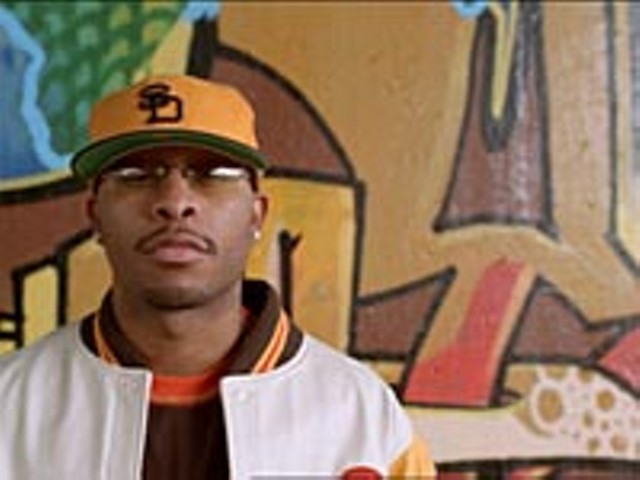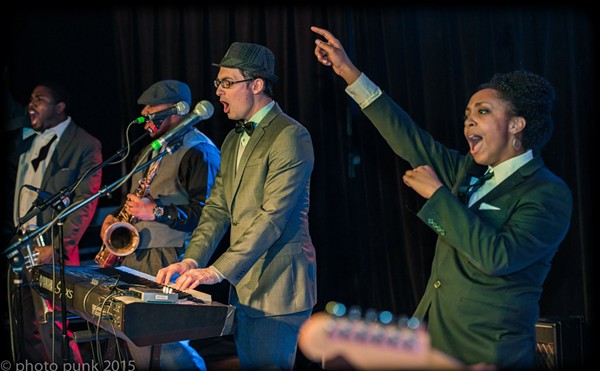Looking for parking near the brand-new Max M. Fisher Center is an experience in Detroit’s ever-present state of contradiction. Driving slowly around the lower section of the Cass Corridor, near the last of the low-income buildings in that area, one can easily get nervous about parking along a too-dark street. But pull behind the new symphony hall, and it’s all lights and bustling activity, as cheery symphony workers in red polo shirts usher cars into the center’s new parking garage for $6, while others guard and greet on the street corners. Symphony-goers walk along the sidewalks in sparkling dresses and coats.
On this lovely weekend night, the much-celebrated center (can it be on the front page of the dailies one more time?) is basking in the magic of the waning sun’s golden glow, as shadows add delight to the gray-brick-and-glass building. Fresh fall air encourages concertgoers to linger outside for a moment.
The Max’s hulking presence is proud — folks are smiling, checking out the new store and facilities. There’s a palpable feeling that this is a step in the right direction.
Tonight is the inaugural night for the new Detroit Symphony Orchestra center, and the DSO has invited a consortium of folks who worked on the building’s construction — renovating the heating and air conditioning, the 84-year-old electrical system, adding 2,000 more seats, dressing, resting and practice rooms for musicians and a coat room for guests — to attend for free. Some 40 unions, 1,600 workers and their family members are represented.
It’s the first in a weeks-long celebration of not only the renovation of the 1919 Orchestra Hall, but of the brand-new facility attached to it, which includes a lobby area with a soaring atrium and the 450-seat Music Box venue that’ll showcase avant-garde chamber music, jazz and world music.
The additions give the symphony the professional rehearsal space and other basics it’s long needed, and fixed stuff like leaky walls. Metro Detroiters raised more than $110 million — including $10 million from philanthropist Max Fisher alone — for the upgrade, and today, a feeling of jubilation is in the air. Where there was little socializing by symphony-goers in the old hall, due to lack of space, tonight the atrium is filled with people standing in lines at several bars, ordering wine, beer and cocktails, on four floors of activity.
The DSO hopes that excitement over the new center brings additional fans — traditionally it’s not a sellout type of Detroit show — and helps the orchestra find a new conductor. Neeme Järvi will celebrate 15 years at the helm of the DSO in 2005, making him the second-longest-serving music director in the organization’s history, after famed Russian conductor Ossip Gabrilowitsch, who led the DSO from 1918 to 1936.
Järvi suffered a rupture in a spinal artery in 2001, and though he is said to be fully recovered, the 2004-2005 season is his final one as director. While the international search for a new conductor is under way, the DSO’s new facility could usher in a whole new era.
“I came here when it was a hole in the ground,” says 42-year-old Local 98 plumber, Brian Muir. “It is really nice to see it come together. … We don’t usually get to enjoy the final product like this.”
These are my kind of folks.
Admittedly, my experience with live music is steeped heavily in the rock ’n’ roll oeuvre. Like many, I enjoy classical music as a means of relaxation and inspiration, but my knowledge of the genre is cursory. However, if there is one thing my nightlife-loving existence has taught me, it is how to spot a good time.
As I mingle, I talk to some of the tradesmen and realize this has all the makings of a fun night. As far as symphony experience goes, everyone’s as much of a novice as me, or seems to be. Charlie Stoll, also a member of Local 98, jokes that his idea of classical music is more “classic rock” than anything else.
We finish our wine and take our seats. My Metro Times companion and I lucked out with box seats right on top of the orchestra, literally. If you ever have a chance to get these $100-plus plum spots, go for it. You and your date won’t be disappointed. You’re so close you can see the funny faces made by the No. 2 cellist, as he sucks his mouth in and out and contorts his cheeks while he and the other cellists rock back and forth in unison with the violinists, all passionately playing their shiny wooden music machines. You nearly smell the hairspray and see the sparkle of gold-rimmed glasses. You can watch as the horn players make faces at each other, roll their eyes, wince after a screw-up and giggle between songs.
Indeed, there’s much to absorb. The majesty of the room is overwhelming. From the chandeliers to the ornate gold leafing, tonight’s experience has quickly become an exercise in grandeur.
When the music starts, it is Tchaikovsky, and notes float through the room as if they were the air itself, filled with poetry. I’m a symphony virgin, and in this music I hear the wail of a pained woman, the joy of a spring day, the triumphs and passions and failures of generations of composers and the societies they commented on. I’m hooked.
Nearly 50 musicians work like an organism — horns, strings, percussion create an ethereal symbiosis. They are a fascinating cross-section of people too: young and old, eccentric and simple, of every ethnicity and upbringing, it appears. Some look like mothers, grandmothers, grandfathers; others like some symphony player with crazy curly gray hair right out of a Woody Allen movie.
I found myself focusing on particularly interesting characters as the show went on. At most concerts, it’s easy to know where your attention should be. But because the symphony offers no true rock-style “front man,” your attention can flow; if you get bored watching the star violinist, you start to watch the handsome flutist, or your eyes may dart to the woman playing the clarinet like it’s her life, and the young man pounding the gargantuan drums. You can’t help but wonder: What path brought them here? How did they learn to play the contrabassoon? The violoncello?
The music is graceful, otherworldly. It takes you away to a time and a place that probably never existed, away from war, away from dirt, away from television. That’s what it feels like in here.
And this place has seen it all, from the grand opening in 1919 to the departure of the DSO two decades later. The hall turned to jazz and popular fare in the ’40s, and it was scheduled for demolition in the 1970s, until the “Save Orchestra Hall” movement ignited. Since the orchestra returned in 1989, the hall has been known again for its excellent acoustics and slightly dilapidated, but still grand aesthetics.
Guest conductor Thomas Wilkins put together a Symphony 101 class for all the workers, who might not have the experience with classical music that regular concert-goers do. Though slightly elementary (even for a greenhorn), the symphony performed a moving overview of classic and show tunes, including Gioacchino Rossini’s William Tell Overture, Leonard Bernstein’s West Side Story overture and a piece from George Gershwin’s Porgy and Bess. The star cellist made a stunning show, his instrument literally singing with emotion.
Wilkins was a hoot, though he went over the top a bit to let the audience know that he’s a regular guy too; he was good-spirited and a charismatic conductor, and the show was an inspiration.
At the finale, Wilkins and the symphony got a heartfelt standing ovation, which brought tears to at least one of my eyes, maybe because the music was so moving, and the crowd of hard workers seemed to love it.
If you need a break from the smoky halls of rawk, check this out. It’ll take you away to a refined space, and you’ll thank yourself for it.
Read an architectural review of the Max here.
From jazz to interpretations of the music of Ravi Shankar to folk to Richard Strauss, the DSO has a packed inaugural schedule. More information can be found here. Eve Doster is the Metro Times listings editor. E-mail [email protected]. Metro Times arts editor Lisa M. Collins also contributed to this





